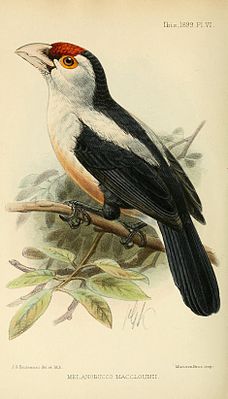Rose-bellied bearded bird
| Rose-bellied bearded bird | ||||||||||
|---|---|---|---|---|---|---|---|---|---|---|

Rose-bellied bearded bird, subspecies Lybius minor macclounii |
||||||||||
| Systematics | ||||||||||
|
||||||||||
| Scientific name | ||||||||||
| Lybius minor | ||||||||||
| ( Cuvier , 1816) |
The rose-bellied bearded bird ( Lybius minor ) is a species from the African bearded bird family . The species occurs in Africa on both sides of the equator. There are two subspecies. The IUCN classifies the rose-bellied bearded bird as not endangered ( least concern ).
Appearance
The males of the nominate form reach a wing length of 8.5 to 9.4 centimeters. The tail length is between 6.3 and 7.5 centimeters. They are therefore relatively long-tailed tooth-bearded birds. The beak length is 2 to 2.4 centimeters. Females have similar body measurements. As is characteristic of tooth-bearded birds, they do not show any pronounced sexual dimorphism .
Males and females have a red, in some individuals also orange, forehead. The front of the head is also red. The rest of the head as well as the sides of the neck and the front back sides are gray-brown. The rest of the upper body is black-brown, the feathers of the upper tail-covers have black tips. The control springs are black. The underside of the body is predominantly white, from the middle of the chest to the belly are reddish orange, the flanks and thighs are black. The beak is reddish ivory to gray horn-colored. The featherless skin around the eyes is pale purple, the eyes are yellow, orange, red, or brown. The legs and feet are flesh-colored to dark brown.
Unlike the nominate form, the subspecies Lybius minor macclounii has white face and neck sides. The top of the body is black, on the back there is a striking, large white V-shaped badge.
The rose-bellied bearded bird can hardly be confused with any other species due to its abdominal color. It is larger and longer-tailed than the Collared Bearded Bird , which has a red head and a black chest band. The rose-bellied bearded bird is more similar to the rare fig bearded bird . However, in this species, the sides of the face are also red, and the back of the head and neck are white. The fig-bearded bird is also shorter-tailed.
Distribution area and habitat
The range of the rose-bellied bearded bird is Gabon , Congo , the Democratic Republic of the Congo , Burundi , Tanzania , Angola , Zambia and north-west Malawi . Rose-bellied bearded birds are regionally common birds, but overall not very common. However, due to their solitary lifestyle and their low reputation, they are often not noticed during field observations. Their altitude distribution ranges from sea level to altitudes of 1,500 meters.
They occur in open forests, on forest edges and on cultivated land such as tree plantations and gardens. They prefer regions with termite mounds, as they use these for the construction of their nesting holes.
Way of life
Rose-bellied bearded birds are territorial birds, the size of the territory is influenced by local conditions. Occasionally three and less often four rose-bellied bearded birds are observed in the area. It is almost certain that the offspring of the parent birds are fully grown, not yet mated. These take on a helper role. Rose-bellied bearded birds search for food around 500 meters from their nesting hole, but nesting holes of rose-bellied bearded birds have also been found that were only about 300 meters apart.
In addition to termite mounds, dead tree trunks or branches are also used to create the nest cavity. The clutch consists of three to four eggs. The breeding and nestling times are unknown. The small honey indicator is almost certainly a breeding parasite of the rose-bellied bearded bird.
supporting documents
literature
- Lester L. Short, Jennifer FM Horne: Toucans, Barbets and Honeyguides - Ramphastidae, Capitonidae and Indicatoridae . Oxford University Press, Oxford 2001, ISBN 0-19-854666-1
Individual evidence
Web link
- Lybius minor inthe IUCN 2013 Red List of Threatened Species . Listed by: BirdLife International, 2012. Retrieved November 23, 2013.